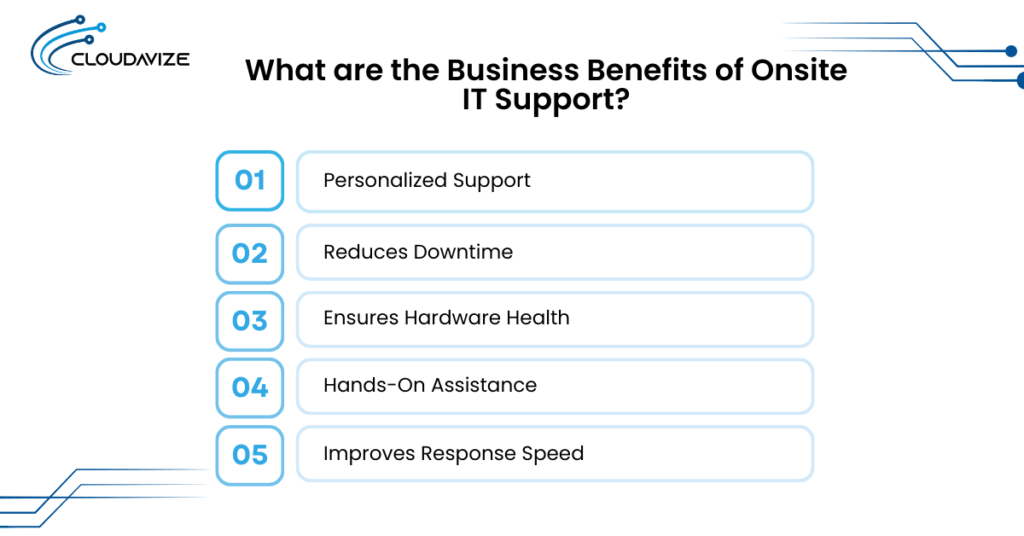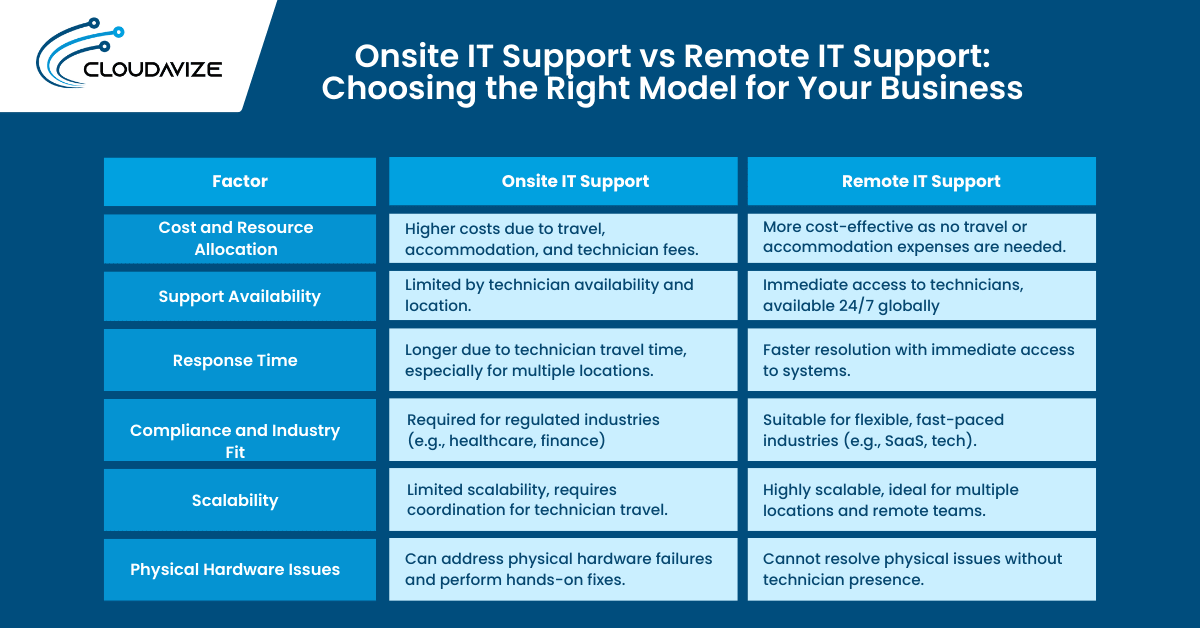Businesses in the current digital era are heavily dependent on IT technologies, and having reliable IT support is more critical than ever. Whether you are running a large corporation or a growing startup, one of the key decisions you will face is choosing between onsite IT support and remote IT support.
Onsite IT support places professionals directly at your business location to troubleshoot and resolve issues in real time. This approach is especially valuable for complex hardware or infrastructure-related problems that require hands-on attention. On the other hand, remote IT support lets technicians access systems virtually, providing quicker solutions for software-related issues through secure internet connections. This model enables businesses to receive 24/7 support, making it a more flexible and scalable option for many.
Both options have their advantages, but choosing the right one depends on your business’s operational structure, regulatory needs, and the complexity of your IT systems. Understanding the differences is essential to selecting the most suitable IT support model for your needs.
Table of Contents
What is Onsite IT Support?
Onsite IT support, also known as on-premise or field IT services, provides in-person technical assistance directly at a business’s physical location. This model allows IT professionals to be physically present to troubleshoot and resolve hardware, network, and software issues efficiently.
Businesses with complex infrastructure or sensitive systems often rely on onsite support for immediate problem resolution. This is especially common in industries such as healthcare and finance, where managing physical assets and minimizing downtime are critical.
For example, if a hospital’s electronic medical records system crashes during peak hours, an onsite IT technician can quickly identify a corrupted server drive and replace it on-site. This rapid response ensures patient care continues uninterrupted, protects sensitive data, and maintains compliance with healthcare regulations.
What are the Business Benefits of Onsite IT Support?
Businesses benefit from onsite IT support through immediate access to expert technical assistance, making it easier to resolve physical issues, ensure infrastructure stability, and enhance overall operational efficiency. This approach is especially valuable in environments where in-person intervention directly contributes to maintaining productivity, meeting compliance requirements, and improving the user experience.

- Personalized Support
Onsite IT support provides tailored solutions by understanding the unique needs of the business. Technicians can assess the environment in person and offer personalized advice or assistance that aligns with specific operational goals, ensuring that technical solutions are context-aware and highly relevant to the company’s needs. - Reduces Downtime
With immediate on-site attention, issues that could potentially cause significant operational delays are quickly addressed. This direct intervention helps minimize downtime, ensuring that critical systems and equipment are up and running faster, which is crucial for businesses that rely on continuous operations and cannot afford disruptions. - Ensures Hardware Health
Physical inspections allow technicians to detect early warning signs of failure, such as overheating CPUs or deteriorating network ports, before they lead to major problems. For businesses, this proactive approach results in fewer unexpected outages, enhanced protection for sensitive equipment, and reduced capital expenditures by prolonging the life of valuable IT assets. - Hands-On Assistance
Having an onsite IT team means technicians can directly troubleshoot and manage devices in person, rather than relying on user descriptions or guiding employees through step-by-step instructions remotely. This hands-on approach allows issues to be diagnosed and resolved more accurately and efficiently, reducing the chances of miscommunication and minimizing downtime. - Improves Response Speed
With technicians available in person, the response time to technical issues is drastically reduced. This immediate availability means problems are dealt with right away, allowing businesses to avoid delays that could impact productivity and operational efficiency.
Challenges of Onsite IT Support
Along with its set of benefits, onsite IT support poses certain challenges for businesses that can impact their overall operational efficiency and scalability. These limitations frequently prompt companies to reassess their support strategies, particularly as they expand or function across multiple locations.

- Higher Operational Costs
Onsite IT support can lead to significant additional costs for businesses, as they must cover expenses such as travel, fuel, and accommodation for technicians. This can become especially burdensome for companies with multiple locations or remote offices. Additionally, deploying technicians on-site results in higher labor costs compared to remote support, which tends to be a more cost-effective solution for addressing routine issues and minor fixes. - Limited Scalability
As a business expands to multiple locations or operates in different regions, maintaining onsite IT support becomes increasingly challenging. Dispatching technicians to various sites can strain resources and make it difficult to provide timely assistance across all locations. This limitation in scalability can lead to slower response times and may require businesses to either hire more staff or rely on third-party service providers, further complicating the support structure. - Availability of Technicians
The availability of skilled IT technicians can be a major challenge, especially in remote or rural areas. Businesses in less populated regions may struggle to find qualified professionals who can respond quickly to urgent issues. In some cases, a business might have to wait for technicians to travel long distances, leading to extended downtime and operational disruptions that affect productivity and efficiency. - Disruption of Workflow
While onsite IT support is designed to fix problems, it can also disrupt regular business operations. Technicians may need to access critical systems, causing temporary slowdowns or requiring teams to adjust their schedules while repairs or troubleshooting are taking place. This disruption can impact productivity, especially in industries where uptime is critical and even brief interruptions can lead to significant setbacks.
What is Remote IT Support?
Remote IT support, also known as virtual troubleshooting or online technical assistance, enables businesses to resolve IT issues through the internet without the need for technicians to be physically present. This model allows IT professionals to access systems, diagnose problems, and implement solutions remotely, typically using tools like remote desktop access, secure logins, and monitoring software.
Businesses with distributed teams or those operating in multiple locations often rely on remote IT support for its efficiency and cost-effectiveness. It is especially beneficial for companies that need quick resolution for routine issues or minor technical problems without waiting for an onsite technician.
For example, if a worker in a different time zone experiences a software malfunction, a remote IT technician can quickly connect to their device, diagnose the problem, and apply the fix, all without the need for an in-person visit. This remote intervention ensures that the employee can get back to work immediately, reducing downtime and maintaining productivity across time zones.
What are the Business Benefits of Remote IT Support?
Businesses benefit from remote IT support by having a flexible and efficient way to resolve technical issues without the physical presence. With no need for onsite technicians, companies can enjoy faster response times, lower operational costs, and continuous access to IT support, ensuring smoother operations across all locations
- Cost Savings
Remote IT support helps businesses reduce costs significantly by eliminating travel, accommodation, and on-site labor expenses. Technicians can resolve issues quickly without the need to physically visit a location, making it more affordable for companies like SMBs, especially those with multiple offices or remote teams. This cost-efficient model is ideal for routine issues or minor fixes that do not require hands-on intervention. - Faster Response Times
With technicians able to access systems remotely, issues can be addressed instantly, without the delays of waiting for a physical visit. This immediate access leads to faster troubleshooting and quicker resolution of technical problems, minimizing downtime and allowing operations to continue without disruption. For businesses that rely heavily on IT systems, this speed is essential to maintaining productivity. - 24/7 Availability
Having access to IT support at any time, day or night, is a major advantage, especially for global businesses or those with employees working across different time zones. With 24/7 remote support, businesses can address technical issues as they arise, ensuring that teams in any location can stay productive without waiting for business hours. This continuous support reduces the risk of downtime and keeps operations running smoothly. - Proactive Monitoring and Maintenance
Remote IT support often includes proactive monitoring tools that can detect potential issues before they escalate into major problems. By continuously monitoring systems, technicians can address concerns, such as network slowdowns or security risks, before they affect business operations. This proactive approach helps prevent downtime, increases system reliability, and reduces the likelihood of costly emergency repairs. - Support for Remote Workers and Distributed Teams
For companies with remote or distributed teams, remote IT support ensures that all employees, no matter where they are located, receive the same level of technical assistance as those working in-office. Technicians can quickly address issues for remote workers, helping to keep them operational and connected with minimal disruption to workflow. This kind of support is essential for modern businesses with flexible work arrangements.
Challenges of Remote IT Support
While remote IT support offers numerous advantages, it also presents certain challenges that can impact its effectiveness in certain business environments. These limitations often lead organizations to re-evaluate their support strategies and consider hybrid or onsite solutions when needed.
- Internet Dependency
Remote IT support relies heavily on a stable internet connection, both for technicians and end-users. If the internet connection is weak or unreliable, it can affect the technician’s ability to access systems and resolve issues. In some cases, a slow or unstable connection may even prevent the technician from connecting to the system, leading to delays in problem resolution. - Security and Access Control Risks
Allowing technicians to access systems remotely introduces cybersecurity risks. Without proper access controls, there is a higher chance of unauthorized access or data breaches. Businesses must implement robust security measures, such as strong encryption, multi-factor authentication, and secure communication channels, to safeguard sensitive information. Failing to secure remote access can compromise data protection and regulatory compliance. - Impersonal Support Experience
Sometimes the support provided by remote IT support can feel less personalized compared to onsite assistance, as there is no direct, face-to-face interaction between the technician and the user. For more complex or high-touch issues, this lack of personal connection may lead to frustration, miscommunication, or inadequate solutions. Users may feel less confident in the support they are receiving, which could impact their experience and overall satisfaction with the service. - Limitations in Resolving Physical Hardware Failures
One of the most significant limitations of remote IT support is its inability to address physical hardware issues effectively. For problems related to broken or malfunctioning hardware, remote troubleshooting can only go so far. In such cases, the technician can diagnose the issue but may not be able to fix it without physically accessing the device or equipment. This limitation often necessitates a switch to onsite support, creating additional delays and logistical challenges.
Onsite vs Remote IT Support: Which is Best for Your Business?
When choosing between on-site and remote IT support for your business, you must evaluate several factors, including operational cost, infrastructure, and structure, to determine which model aligns best with your needs. As businesses of all sizes increasingly adopt hybrid work models, there is a growing need to evaluate how IT support aligns with the unique challenges of today’s distributed workforce. Especially if you fall under a small to medium-sized business (SMBs), you need to be more careful with your decision.
- Cost and Resource Allocation:
Onsite IT support often comes with higher costs, including travel, accommodation, and higher labor fees. This makes it less cost-effective for routine issues or businesses with widespread locations. Remote support, on the other hand, eliminates these expenses, making it ideal for companies looking to reduce operational costs, especially for routine technical issues. However, businesses must weigh the cost savings against the need for physical intervention for more complex issues. - Support Availability and Response Time:
Remote IT support provides the advantage of immediate access, often reducing resolution time by allowing technicians to fix problems instantly. It is ideal for businesses that require fast, around-the-clock assistance or have global operations. Onsite support is better for businesses that prioritize in-person service for critical, high-priority issues, but it may involve longer wait times due to technician travel, especially for businesses with multiple locations. - Compliance and Industry Fit:
Certain industries, such as healthcare, finance, and manufacturing, may require onsite IT support to comply with strict data protection, security, or regulatory standards. Onsite presence ensures that sensitive data is handled appropriately and in person, which is essential in these sectors. In contrast, industries like SaaS or tech companies that are more agile can benefit from the flexibility of remote support, which ensures constant uptime and global service reach.= - Scalability
Remote IT support is more scalable, as it can be deployed across multiple locations or for remote teams without added logistical efforts. Whereas onsite support requires more coordination, especially for businesses with multiple offices or distributed teams, due to technician travel and resource allocation.
Here is a table for highlighting the key differences between onsite and remote IT support:
| Factor | Onsite IT Support | Remote IT Support |
| Cost and Resource Allocation | Higher costs due to travel, accommodation, and technician fees. | More cost-effective as no travel or accommodation expenses are needed. |
| Support Availability | Limited by technician availability and location. | Immediate access to technicians, available 24/7 globally. |
| Response Time | Longer due to technician travel time, especially for multiple locations. | Faster resolution with immediate access to systems. |
| Compliance and Industry Fit | Required for regulated industries (e.g., healthcare, finance). | Suitable for flexible, fast-paced industries (e.g., SaaS, tech). |
| Scalability | Limited scalability, requires coordination for technician travel. | Highly scalable, ideal for multiple locations and remote teams. |
| Physical Hardware Issues | Can address physical hardware failures and perform hands-on fixes. | Cannot resolve physical issues without technician presence. |
While these differences provide valuable insights, the choice of IT support model depends on each business’s unique needs. Some organizations may benefit from the immediacy of onsite support or the efficiency of remote services, but many find that a hybrid approach delivers the best results. A hybrid IT support model combines the cost-effectiveness of remote services with the hands-on expertise of onsite technicians when necessary. By considering factors like system complexity, compliance requirements, and available resources, businesses can create a tailored support strategy that maximizes reliability and long-term value.
Choose Reliable IT Support for Your Business
In an age where technology drives business success, the decision of how to manage your IT infrastructure is important. Whether you choose the hands-on, immediate resolution of onsite support or the flexible, cost-effective nature of remote assistance, the most critical factor is the reliability of your chosen IT support services. Alternatively, a hybrid IT support model, tailored to meet the evolving needs of small to medium-sized businesses (SMBs), offers a balanced solution.
A hybrid IT strategy ensures business continuity and support flexibility, allowing you to focus on your core operations while we manage your technology. Here are the key benefits of the hybrid approach:
- Combines Remote Agility with Onsite Precision: Hybrid IT support offers immediate remote support for software issues, while the onsite team is ready for complex hardware problems that require a physical presence.
- Reduces Downtime While Controlling Costs: By resolving most issues remotely, hybrid helps you save on travel and labor expenses. For critical issues, rapid onsite deployment ensures that downtime is minimized.
- Scales Flexibly as Your Business Grows: As your business grows, hybrid IT support scales with you, providing both remote and onsite resources as your company’s needs expand.
- Delivers 360° Support for Distributed Teams: Whether your employees are in the office or working remotely, the hybrid integrated model ensures they have access to the support they need.
By carefully evaluating your business’s unique needs and selecting a proper IT support service and provider that aligns with your operational structure and goals, you can ensure seamless operations, minimize downtime, and build a resilient foundation for future growth. Ultimately, investing in reliable IT support is not just a choice, it is a strategic necessity for thriving in the modern digital landscape.



